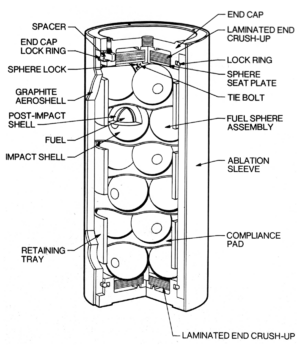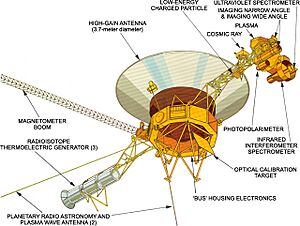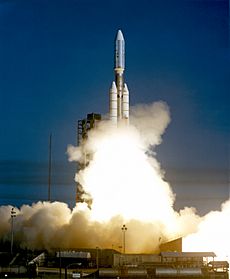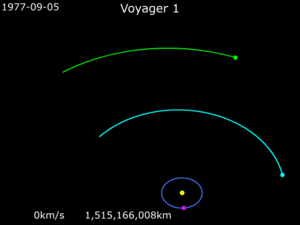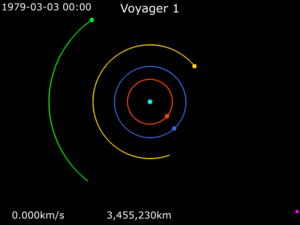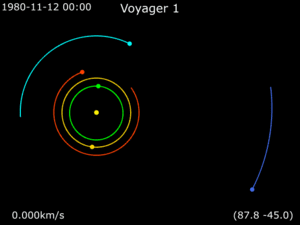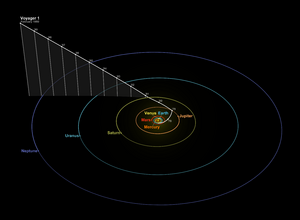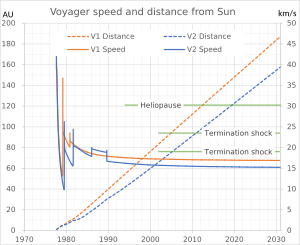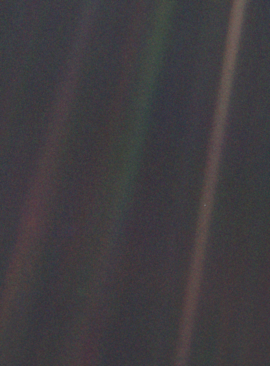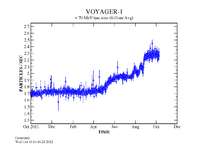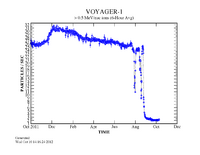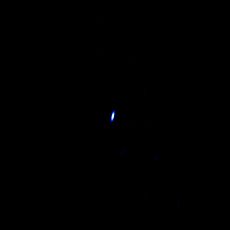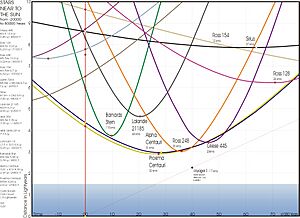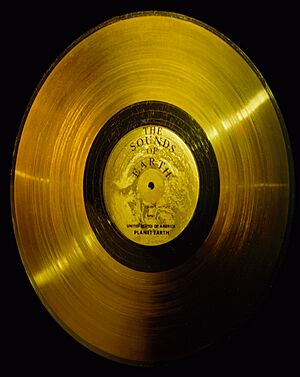Voyager 1 facts for kids
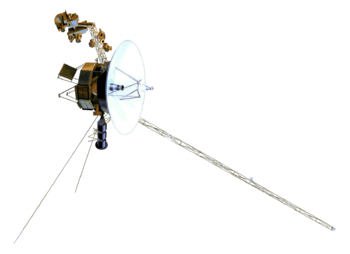
Artist's rendering of the Voyager spacecraft
|
|
| Mission type | Outer planetary, heliosphere, and interstellar medium exploration |
|---|---|
| Operator | NASA/Jet Propulsion Laboratory |
| Mission duration |
elapsed
|
| Spacecraft properties | |
| Spacecraft type | Mariner Jupiter-Saturn |
| Manufacturer | Jet Propulsion Laboratory |
| Launch mass | 815 kg (1,797 lb) |
| Dry mass | 721.9 kg (1,592 lb) |
| Power | 470 watts (at launch) |
| Start of mission | |
| Launch date | September 5, 1977, 12:56:01 UTC |
| Rocket | Titan IIIE |
| Launch site | Cape Canaveral Launch Complex 41 |
| End of mission | |
| Last contact | 2036 (estimated) |
| Flyby of Jupiter | |
| Closest approach | March 5, 1979 |
| Distance | 349,000 km (217,000 mi) |
| Flyby of Saturn | |
| Closest approach | November 12, 1980 |
| Distance | 124,000 km (77,000 mi) |
| Flyby of Titan (atmosphere study) | |
| Closest approach | November 12, 1980 |
| Distance | 6,490 km (4,030 mi) |
|
Large Strategic Science Missions (Planetary Science Division)
|
|
Voyager 1 is a special robot space probe launched by NASA on September 5, 1977. It is part of the Voyager program. Its main job was to explore the outer parts of our Solar System. It also studies the space beyond the Sun's influence, called the interstellar space.
Voyager 1 was launched just 16 days after its twin, Voyager 2. It talks to Earth using the NASA Deep Space Network. This network sends commands to the probe and receives data back. Voyager 1 is the farthest human-made object from Earth. It is currently about 166.40 AU (24.9 billion km; 15.5 billion mi) away.
The probe flew past Jupiter, Saturn, and Saturn's largest moon, Titan. NASA chose to explore Titan because it has a thick atmosphere. Voyager 1 studied the weather, magnetic fields, and rings of these giant planets. It also sent back the first detailed pictures of their moons.
After its main mission, Voyager 1 continued its journey. Its goal was to find and study the edge of the Sun's influence, called the heliopause. It crossed this boundary and entered interstellar space on August 25, 2012. This made it the first spacecraft ever to do so.
In 2017, the team successfully used the spacecraft's small thrusters for the first time since 1980. This helped extend the mission. Voyager 1 is expected to keep sending scientific data until at least 2025. It might even send engineering data until 2036.
Contents
Mission Journey
In the 1960s, scientists dreamed of a "Grand Tour" to study the outer planets. This led NASA to start planning a mission in the early 1970s. Voyager 1 was first planned as Mariner 11. But due to budget cuts, the mission was changed to only fly by Jupiter and Saturn. It was then renamed the Mariner Jupiter-Saturn probes. Later, the name became simply Voyager because the spacecraft designs were very different from earlier Mariner missions.
Spacecraft Parts
Voyager 1 was built by the Jet Propulsion Laboratory (JPL). It has a ten-sided body. It uses 16 small thrusters and gyroscopes to stay stable. These help keep its radio antenna pointed towards Earth. All these parts work together to control the spacecraft's direction. The spacecraft also carries 11 science tools to study planets and other objects in space.
How it Communicates
The radio communication system on Voyager 1 was built to work far beyond the Solar System. It has a large, 3.7-meter (12 ft) wide dish antenna. This antenna sends and receives radio waves to and from Earth. It uses three special stations on Earth called the Deep Space Network.
When Voyager 1 cannot talk to Earth, it can record data. It has a digital tape recorder that can save about 67 kilobytes of information. As of 2023, it takes more than 22 hours for a signal from Voyager 1 to reach Earth.
How it Gets Power
Voyager 1 gets its power from three special generators. They are called radioisotope thermoelectric generators (RTGs). These RTGs use plutonium-238 to create heat. This heat is then turned into electric power. When launched, they made about 470 watts of power.
Over time, the power from the RTGs slowly decreases. This is because the fuel slowly decays. But these generators are very long-lasting. They are expected to keep some parts of the spacecraft working until at least 2025.
Onboard Computers
Voyager 1 has several computers. The Flight Data Subsystem (FDS) helps control the cameras. It also stores information about how to take pictures. The computer command subsystem (CCS) handles many tasks. These include understanding commands, fixing problems, and pointing the antenna. This computer is an improved version of those used in the 1970s Viking orbiters.
The Attitude and Articulation Control Subsystem (AACS) keeps the spacecraft pointed correctly. It makes sure the main antenna always faces Earth. It also controls how the spacecraft moves and where its science tools look. Both Voyager probes have the same AACS system.
Science Tools
Voyager 1 carries many important science tools. Each tool is managed by a lead scientist.
- Imaging Science System (ISS): This system has two cameras. It took pictures of Jupiter, Saturn, and other objects.
- Radio Science System (RSS): This uses the spacecraft's radio system. It helps figure out things like the size and weight of planets and moons. It also studies Saturn's rings.
- Infrared Interferometer Spectrometer and Radiometer (IRIS): This tool studies how much energy planets give off. It also looks at what their atmospheres are made of. It helped measure temperatures on planets and moons.
- Ultraviolet Spectrometer (UVS): This tool studied atmospheres and measured radiation. It was turned off in 2016 to save power.
- Triaxial Fluxgate Magnetometer (MAG): This tool studied the magnetic fields of Jupiter and Saturn. It also looked at how the Sun's wind interacts with these fields.
- Plasma Spectrometer (PLS): This tool studied tiny charged particles called plasma ions and electrons.
- Low Energy Charged Particle Instrument (LECP): This tool measured different types of charged particles and their energy.
- Cosmic Ray System (CRS): This tool studied cosmic rays. These are high-energy particles from outside our Solar System.
- Planetary Radio Astronomy Investigation (PRA): This tool listened to radio signals coming from Jupiter and Saturn.
- Photopolarimeter System (PPS): This tool used a telescope to learn about the surfaces of Jupiter and Saturn. It also studied their atmospheres.
- Plasma Wave Subsystem (PWS): This tool measured the density of electrons around Jupiter and Saturn. It also studied how waves and particles interact in space.
Mission Journey Timeline
 Voyager 1's path seen from Earth. It left the plane of the ecliptic in 1981 and is now heading towards the constellation Ophiuchus. |
| Date | Event |
|---|---|
| 1977-09-05 | Spacecraft launched at 12:56:00 UTC. |
| 1977-12-10 | Entered asteroid belt. |
| 1977-12-19 | Voyager 1 passed Voyager 2. |
| 1978-09-08 | Left the asteroid belt. |
| 1979-01-06 | Started observing Jupiter. |
| 1979-03-05 | Close encounter with Jupiter and its moons. |
| 06:54 | Flew by Amalthea at 420,200 km. |
| 12:05:26 | Closest approach to Jupiter at 348,890 km from its center. |
| 15:14 | Flew by Io at 20,570 km. |
| 18:19 | Flew by Europa at 733,760 km. |
| 1979-03-06 | |
| 02:15 | Flew by Ganymede at 114,710 km. |
| 17:08 | Flew by Callisto at 126,400 km. |
| 1979-04-13 | Jupiter observation phase ended. |
| 1980-08-22 | Started observing Saturn. |
| 1980-11-12 | Close encounter with Saturn and its moons. |
| 05:41:21 | Flew by Titan at 6,490 km. |
| 22:16:32 | Flew by Tethys at 415,670 km. |
| 23:46:30 | Closest approach to Saturn at 184,300 km from its center. |
| 1980-11-13 | |
| 01:43:12 | Flew by Mimas at 88,440 km. |
| 01:51:16 | Flew by Enceladus at 202,040 km. |
| 06:21:53 | Flew by Rhea at 73,980 km. |
| 16:44:41 | Flew by Hyperion at 880,440 km. |
| 1980-11-14 | Saturn observation phase ended. |
| 1980-11-14 | Began its extended mission into deep space. |
| Extended Mission Highlights | |
|---|---|
| 1990-02-14 | Took the final images of the Voyager program. This included the famous Family Portrait of the Solar System. |
| 1998-02-17 | Voyager 1 passed Pioneer 10. It became the farthest spacecraft from the Sun. |
| 2004-12-17 | Crossed the termination shock at 94 AU. This is where the solar wind slows down. |
| 2007-02-02 | Plasma subsystem operations were turned off. |
| 2007-04-11 | Plasma subsystem heater was turned off. |
| 2008-01-16 | Planetary radio astronomy experiment operations were turned off. |
| 2012-08-25 | Crossed the heliopause at 121 AU. It entered interstellar space, becoming the first human-made object to leave the Solar System. |
| 2014-07-07 | More data confirmed the probe was in interstellar space. |
| 2016-04-19 | Ultraviolet Spectrometer operations were turned off. |
| 2017-11-28 | "Trajectory correction maneuver" (TCM) thrusters were tested. This was their first use since November 1980. |
| 2023-11-14 | Began sending unreadable data due to an onboard computer issue. |
| 2024-04-22 | Engineers fixed the communication problem. They moved code away from a broken memory chip. |
| 2025-02-25 | Cosmic ray subsystem was turned off. |
Launch and Path
Voyager 1 launched on September 5, 1977. It lifted off from Cape Canaveral Air Force Station in Florida. It rode on a Titan IIIE rocket. Its twin, Voyager 2, had launched two weeks earlier. Even though it launched later, Voyager 1 reached Jupiter and Saturn first. This was because it followed a shorter path.
The launch of Voyager 1 almost failed. Part of the rocket shut down too early. But the Centaur stage's computers worked extra hard. They burned for much longer than planned to make up for it. This extra burn gave Voyager 1 the speed it needed. The Centaur stage ran out of fuel just 3.4 seconds before it was supposed to.
Jupiter Flyby
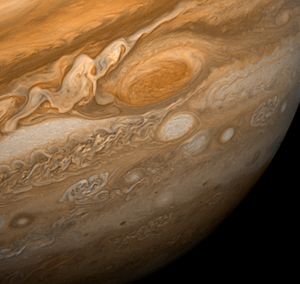
Voyager 1 started taking pictures of Jupiter in January 1979. It came closest to Jupiter on March 5, 1979. It was about 349,000 kilometers (217,000 miles) from the planet's center. Most of the detailed observations of Jupiter's moons, rings, and magnetic fields happened during a 48-hour period around this closest approach. Voyager 1 finished photographing Jupiter in April 1979.
Scientists learned a lot from the Pioneer 10 spacecraft. This helped them design Voyager to handle Jupiter's strong radiation. They even added strips of aluminum foil to some cables for better protection.
The biggest surprise was finding active volcanoes on Jupiter's moon Io. This was the first time active volcanoes were seen on another body in our Solar System. Io's activity seems to affect the whole Jovian system. Io is a main source of material that fills Jupiter's magnetosphere. This is the area of space around Jupiter controlled by its strong magnetic field.
Voyager 1 and Voyager 2 made many important discoveries about Jupiter. They found new things about its moons, radiation belts, and its never-before-seen planetary rings.
Saturn Flyby
Both Voyager probes successfully used Jupiter's gravity to speed up. This helped them travel to Saturn and its system of moons and rings. Voyager 1 reached Saturn in November 1980. Its closest approach was on November 12, 1980. It came within 124,000 kilometers (77,000 mi) of Saturn's cloud tops.
The probe's cameras saw complex structures in the rings of Saturn. Its tools also studied the atmospheres of Saturn and its giant moon Titan. Voyager 1 found that Saturn's upper atmosphere is about seven percent helium. The rest is mostly hydrogen. Scientists think the helium might be slowly sinking through the hydrogen. This could explain why Saturn gives off more heat than it gets from the Sun.
Winds on Saturn blow very fast. Near the equator, the Voyagers measured winds around 500 m/s (1,100 mph). These winds mostly blow east. The Voyagers also found aurora-like ultraviolet light in Saturn's atmosphere. These auroras are similar to the Northern and Southern Lights on Earth. Both Voyagers measured Saturn's day length. It is 10 hours, 39 minutes, and 24 seconds long.
A key part of Voyager 1's mission was to fly by Titan. This is Saturn's largest moon. Scientists knew Titan had an atmosphere. Pictures from Pioneer 11 in 1979 showed it was thick and complex. This made Titan even more interesting. The Titan flyby happened early in the mission. This was to make sure observations were not ruined by any damage closer to Saturn. Voyager 1 passed within 6,400 km (4,000 mi) of Titan.
Voyager measured how Titan's atmosphere affected sunlight and radio signals. This helped scientists figure out what the atmosphere was made of. They also learned about its density and pressure. Titan's mass was measured by how it pulled on the probe's path. A thick haze on Titan prevented seeing its surface. But the atmospheric data made scientists wonder if there could be lakes of liquid hydrocarbons on the surface.
The Titan flyby was so important that Voyager 1's path was designed around it. This path took the probe below Saturn's south pole. It also took it out of the plane where most planets orbit, called the ecliptic. This ended its main planetary science mission. If Voyager 1 had failed to observe Titan, Voyager 2 would have changed its path to do so. This would have stopped Voyager 2 from visiting Uranus and Neptune.
Leaving the Solar System
On February 14, 1990, Voyager 1 took the first "family portrait" of our Solar System from far away. This included the famous image of Earth known as the Pale Blue Dot. Soon after, its cameras were turned off to save power and computer resources for other tools. The camera software has been removed from the spacecraft. It would be very hard to get them working again now.
On February 17, 1998, Voyager 1 reached 69 AU (6.4 billion mi; 10.3 billion km) from the Sun. It passed Pioneer 10 to become the farthest spacecraft from Earth. It travels at about 17 km/s (11 mi/s). This is the fastest speed away from the Sun for any spacecraft.
As Voyager 1 moved towards interstellar space, its tools kept studying the Solar System. Scientists used its plasma wave tools to look for the heliopause. This is the boundary where the solar wind meets the interstellar medium. The probe is moving at about 61,197 kilometers per hour (38,026 mph) relative to the Sun. At this speed, it travels about 523 million km (325 million mi) each year. This means it takes about 18,000 years to travel one light-year.
Termination Shock

Scientists believe Voyager 1 entered the termination shock in February 2003. This is where the solar wind slows down to slower-than-sound speeds. In May 2005, NASA announced that Voyager 1 was in the heliosheath. This event is thought to have happened on December 15, 2004. It was about 94 AU (8,700 million mi) from the Sun.
Heliosheath
On March 31, 2006, amateur radio operators in Germany successfully received radio waves from Voyager 1. This was the first time amateurs had tracked the probe.
On December 13, 2010, it was confirmed that Voyager 1 had passed the area where the solar wind flows outward. Scientists think the solar wind turns sideways at this distance. This is because of the interstellar wind pushing against the heliosphere. Since June 2010, the solar wind detection had been consistently zero. This showed that the event had happened. At this time, the spacecraft was about 116 AU (17.4 billion km; 10.8 billion mi) from the Sun.
In March 2011, Voyager 1 was told to change its direction. This was to measure the sideways movement of the solar wind. This was the first major maneuver for the spacecraft since the Family Portrait was taken in 1990. After the change, the spacecraft easily reoriented itself. It continued sending data back to Earth.
On December 1, 2011, Voyager 1 detected the first Lyman-alpha radiation from the Milky Way galaxy. This radiation had been hidden by the Sun's interference before.
On December 5, 2011, NASA announced that Voyager 1 had entered a new area. They called it a "cosmic purgatory." In this area, charged particles from the Sun slow down and turn inward. The Solar System's magnetic field also doubles in strength. This is because interstellar space seems to be pushing on it.
Heliopause
In June 2012, NASA announced that the probe was detecting changes. These changes were thought to mean it was reaching the heliopause. Voyager 1 saw a big increase in charged particles from interstellar space. These particles are usually blocked by the solar winds. This meant the craft was starting to enter the interstellar medium.
Voyager 1 became the first spacecraft to cross the heliopause in August 2012. It was then 121 AU (1.12×1010 mi; 1.81×1010 km) from the Sun. This was officially confirmed a year later.
As of September 2012, sunlight took 16.89 hours to reach Voyager 1. The Sun looked very bright from the spacecraft, about 30 times brighter than a full Moon. The spacecraft was traveling at 17.043 km/s (10.590 mi/s) relative to the Sun. At this speed, it would take about 17,565 years to travel one light-year. For comparison, Proxima Centauri, the closest star to the Sun, is about 4.2 light-years away. Voyager 1 is heading towards the constellation Ophiuchus.
In late 2012, data from the spacecraft suggested it had passed through the heliopause. Measurements showed a steady rise in high-energy particles (like cosmic rays from supernova explosions). At the same time, there was a big drop in low-energy particles from the Sun.
Interstellar Space
In March 2013, it was announced that Voyager 1 might be the first spacecraft to enter interstellar space. It had detected a big change in the plasma around it on August 25, 2012. On September 12, 2013, this was officially confirmed. The new region was indeed interstellar space.
In 2013, Voyager 1 was leaving the Solar System at about 3.6 AU (330 million mi; 0.54 billion km) per year. This is 61,602 km/h. Voyager 2 is going slower, at 3.3 AU (310 million mi; 0.49 billion km) per year. Each year, Voyager 1 gets farther ahead of Voyager 2.
Voyager 1 reached 135 AU (12.5 billion mi; 20.2 billion km) from the Sun on May 18, 2016. By September 5, 2017, it was about 139.64 AU (12.980 billion mi; 20.890 billion km) from the Sun. This is just over 19 light-hours away. You can track its progress on NASA's website.
-
This graph shows a big increase in cosmic ray particles detected by Voyager 1 from October 2011 to October 2012.
-
This graph shows a big decrease in solar wind particles detected by Voyager 1 from October 2011 to October 2012.
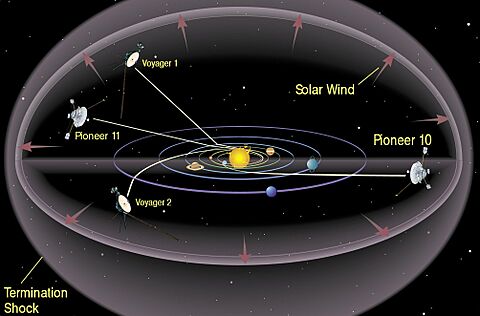
On September 12, 2013, NASA officially confirmed that Voyager 1 had reached the interstellar medium in August 2012. The accepted date is August 25, 2012. This is when lasting changes in the density of energetic particles were first seen. By this point, most scientists agreed that a change in magnetic field direction was not needed to confirm crossing the heliopause.
A key finding was an 80-fold increase in electron density. This was based on plasma oscillations seen starting April 9, 2013. These were caused by a solar outburst in March 2012. Electron density is expected to be much higher outside the heliopause. In September 2013, NASA released audio recordings of these plasma waves. These were the first sounds measured in interstellar space.
While Voyager 1 is said to have left the Solar System, it has not fully done so. The Solar System is a much larger area. It includes all bodies that orbit the Sun. The craft is still less than one-seventh of the way to the farthest point of 90377 Sedna's orbit. It has not yet entered the Oort cloud. This cloud is the source of long-period comets. Astronomers see it as the outermost part of the Solar System.
In October 2020, astronomers reported a surprising increase in density in the space beyond the Solar System. This was detected by Voyager 1 and Voyager 2. This suggests that the density changes are a large feature of the local interstellar medium. In May 2021, NASA reported the first continuous measurement of material density in interstellar space. They also detected interstellar sounds for the first time.
Communication Challenges
In May 2022, NASA reported that Voyager 1 was sending "mysterious" data. This was from its Attitude Articulation and Control System (AACS). The AACS was working, but sending invalid data. The problem was found to be the AACS sending data through a computer that had been off for years. This caused the data to be corrupted. In August 2022, NASA sent a command to the AACS to use another computer. This fixed the problem.
Voyager 1 started sending unreadable data again on November 14, 2023. By December 12, 2023, NASA announced that the flight data system could not send scientific data. On March 24, 2024, NASA said they were making progress in understanding the data. Engineers reported in April 2024 that a memory bank in the Flight Data Subsystem (FDS) was likely damaged. This could be from a high-energy particle or just old age.
The FDS was not talking correctly with the telemetry unit. This caused it to send a repeating sequence of ones and zeros. After a reboot, communications were still unusable. But the probe still received commands from Earth. It also sent a signal showing it was still working. Commands to change the signal worked, confirming the probe was still responsive.
The Voyager team started working on a fix. On April 20, communication of health and status was restored. They moved code away from the broken FDS memory chip. About three percent of the memory was too damaged to fix. To make space, engineers deleted old code. For example, code used to send data from Jupiter was removed. All data from the "anomaly period" was lost. On May 22, NASA announced that Voyager 1 was sending science data from two of its four instruments again. By June 13, all four instruments were sending data.
In October 2024, the probe turned off its X-band radio transmitter. This was used for talking to the Deep Space Network. It happened after NASA turned on one of the heaters. The fault protection system lowered the transmission rate. Engineers found the signal. Later, on October 19, the transmission stopped. The fault protection system switched to the S-band transmitter. This had not been used since 1981. NASA reported that the X-band transmitter was reactivated. Data collection resumed in mid-November.
Between May 4, 2025, and February 2026, a key antenna in Canberra will be offline for upgrades. This antenna is the only one that can send commands to Voyager 1 and 2. This created a deadline for engineers to fix backup thrusters.
Future of the Probe
| Probe | Speed |
|---|---|
| Pioneer 10 | 11.8 km/s (2.49 au/yr) |
| Pioneer 11 | 11.1 km/s (2.34 au/yr) |
| Voyager 1 | 16.9 km/s (3.57 au/yr) |
| Voyager 2 | 15.2 km/s (3.21 au/yr) |
| New Horizons | 12.6 km/s (2.66 au/yr) |
Remaining Lifespan
In December 2017, NASA successfully fired all four of Voyager 1's thrusters. These thrusters help keep the probe's antenna pointed towards Earth. Using these thrusters allowed Voyager 1 to keep sending data for two to three more years.
The electrical power on Voyager 1 is slowly decreasing. The team has to decide which instruments to keep on. Heaters and other systems have been turned off one by one to save power. The tools that study fields and particles are most important. They are likely to send back key data about interstellar space. Engineers expect the spacecraft to keep at least one science instrument working until around 2025.
| Year | What was turned off to save power |
|---|---|
| 1998 | Ultraviolet Spectrometer (UVS) was turned off. |
| 2007 | Plasma subsystem (PLS) was turned off. |
| 2008 | Planetary Radio Astronomy Experiment (PRA) was turned off. |
| 2016 | Scan platform and Ultraviolet Spectrometer (UVS) observations were stopped. |
| Unknown date | Science instruments started to be turned off. (Some key instruments like Low-Energy Charged Particles, Cosmic Ray Subsystem, Magnetometer, and Plasma Wave Subsystem are expected to still work.) |
| Unknown date | Data Tape Recorder (DTR) operations will stop. |
| Unknown date | Gyroscopic operations will stop. |
| 2025–2036 | Will no longer have enough power for even one instrument. After 2036, both probes will be too far for the Deep Space Network to reach. |
Thruster Concerns
Some of the thrusters that control the spacecraft's direction are not working well. This is due to clogs in their fuel lines. The spacecraft no longer has a backup for its thruster system. Everything on board is now "single-string," meaning there's no backup. NASA decided to change the spacecraft's computer software. This will help reduce how fast the fuel lines clog. NASA will first try the new software on Voyager 2, which is closer to Earth.
In September 2024, NASA performed a "thruster swap." They switched from clogged thrusters to less used ones. These had not been used since 2018. In May 2025, the team was able to get the backup thrusters for roll motion working again. These had been unusable since 2004.
Far Future
If Voyager 1 does not hit anything and is not found, the New Horizons space probe will never pass it. Even though New Horizons launched faster, Voyager 1 got extra speed from flying by multiple planets. New Horizons only got one boost from Jupiter in 2007. As of 2018, New Horizons is traveling slower than Voyager 1. It is also slowing down faster because it is closer to the Sun.
Voyager 1 is expected to reach the theorized Oort cloud in about 300 years. It will take about 30,000 years to pass through it. The Oort cloud is a huge shell of icy objects far beyond the planets. Even though it is not heading towards any specific star, in about 40,000 years, it will pass within 1.6 light-years (0.49 parsecs) of the star Gliese 445. This star is currently in the constellation Camelopardalis. NASA says that "The Voyagers are destined—perhaps eternally—to wander the Milky Way." In 300,000 years, it will pass very close to the star TYC 3135–52–1.
Golden Record
Both Voyager space probes carry a special gold-plated disc. It is called the Voyager Golden Record. This disc is like a time capsule. It is meant to show the variety of life and culture on Earth. It is there in case either spacecraft is ever found by aliens.
A team led by Carl Sagan created the record. It includes photos of Earth and its living things. It also has scientific information. There are spoken greetings from people like the Secretary-General of the United Nations and the President of the United States. It also has a mix of "Sounds of Earth." These include sounds of whales, a baby crying, and ocean waves.
The record also has music from different cultures and times. This includes works by Wolfgang Amadeus Mozart, Blind Willie Johnson, Chuck Berry, and Valya Balkanska. It also has greetings in 55 different languages. The project wanted to show how rich life on Earth is. It also shows humanity's desire to connect with the cosmos.
See also
 In Spanish: Voyager 1 para niños
In Spanish: Voyager 1 para niños
- The Farthest, a 2017 movie about the Voyager program
- Interstellar probe
- List of artificial objects leaving the Solar System
- List of missions to the outer planets
- Local Interstellar Cloud
- Space exploration
- Specific orbital energy of Voyager 1
- Timeline of artificial satellites and space probes


